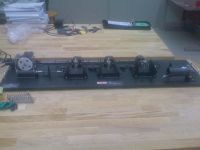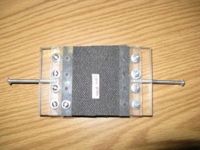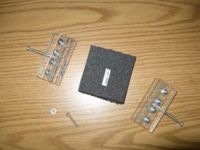Ski boot walking attachment analysis
From DDL Wiki
(→Determination of Spring Constants and Damping Coefficients) |
|||
| Line 2: | Line 2: | ||
==Taka== | ==Taka== | ||
==Determination of Spring Constants and Damping Coefficients== | ==Determination of Spring Constants and Damping Coefficients== | ||
| + | |||
| + | '''Purpose of the Analysis''' | ||
| + | |||
| + | We are doing this analysis to obtain at least ballpark figures for the spring constant and damping coefficient of each of the materials we will be using to construct the body of our walking attachment. These are important because they allow us to actually have numbers instead of vague ideas about how well the materials act as springs and dampers. In addition, Taka and Brandon need some kind of ballpark values in order to make their analyses more accurate and more useful. | ||
| + | |||
| + | '''Overview of Method''' | ||
| + | [[Image:SkiBoot_RectilinearSetup.JPG|right|thumb|200px|Rectilinear system used to test material properties.]] | ||
| + | In order to obtain values for the spring constant and damping coefficient of each material, we will use the rectilinear experimental setup used in the Mechanical Systems Experimentation lab. This setup, as pictured to the right, consists of carts attached to tracks with encoders used to measure displacement. We can attach the carts to a stationary post using springs, or, in this case, our materials. In order to find the spring constant and damping coefficient, we can manually move the carts and find the response. Using MATLAB code developed for our MSE labs, we can use the logarithmic decrement method to find the spring constants and camping coefficients. Additionally, we can check our results for the spring constants by using a ramp function input and the dividing the input force by the displacement response over the course of the run. With these two tests run together, we can get at least some idea of the spring constant, and with just the one test we can get some somewhat accurate idea of the damping coefficient. | ||
| + | |||
| + | In order to attach the materials to the rectilinear system, we had to specially design brackets to hold the materials and clamp on to the provided posts and carts. To do this, we used the system pictured below. | ||
| + | |||
| + | [[Image:SkiBoot_MaterialMount.jpg|right|thumb|200px|Mount with material inside.]] | ||
| + | [[Image:SKiBoot_MaterialMount2.jpg|right|thumb|200px|Mount and material taken apart with screw used to put material in mount.]] | ||
Revision as of 17:55, 10 November 2008
Brandon
Taka
Determination of Spring Constants and Damping Coefficients
Purpose of the Analysis
We are doing this analysis to obtain at least ballpark figures for the spring constant and damping coefficient of each of the materials we will be using to construct the body of our walking attachment. These are important because they allow us to actually have numbers instead of vague ideas about how well the materials act as springs and dampers. In addition, Taka and Brandon need some kind of ballpark values in order to make their analyses more accurate and more useful.
Overview of Method
In order to obtain values for the spring constant and damping coefficient of each material, we will use the rectilinear experimental setup used in the Mechanical Systems Experimentation lab. This setup, as pictured to the right, consists of carts attached to tracks with encoders used to measure displacement. We can attach the carts to a stationary post using springs, or, in this case, our materials. In order to find the spring constant and damping coefficient, we can manually move the carts and find the response. Using MATLAB code developed for our MSE labs, we can use the logarithmic decrement method to find the spring constants and camping coefficients. Additionally, we can check our results for the spring constants by using a ramp function input and the dividing the input force by the displacement response over the course of the run. With these two tests run together, we can get at least some idea of the spring constant, and with just the one test we can get some somewhat accurate idea of the damping coefficient.
In order to attach the materials to the rectilinear system, we had to specially design brackets to hold the materials and clamp on to the provided posts and carts. To do this, we used the system pictured below.



